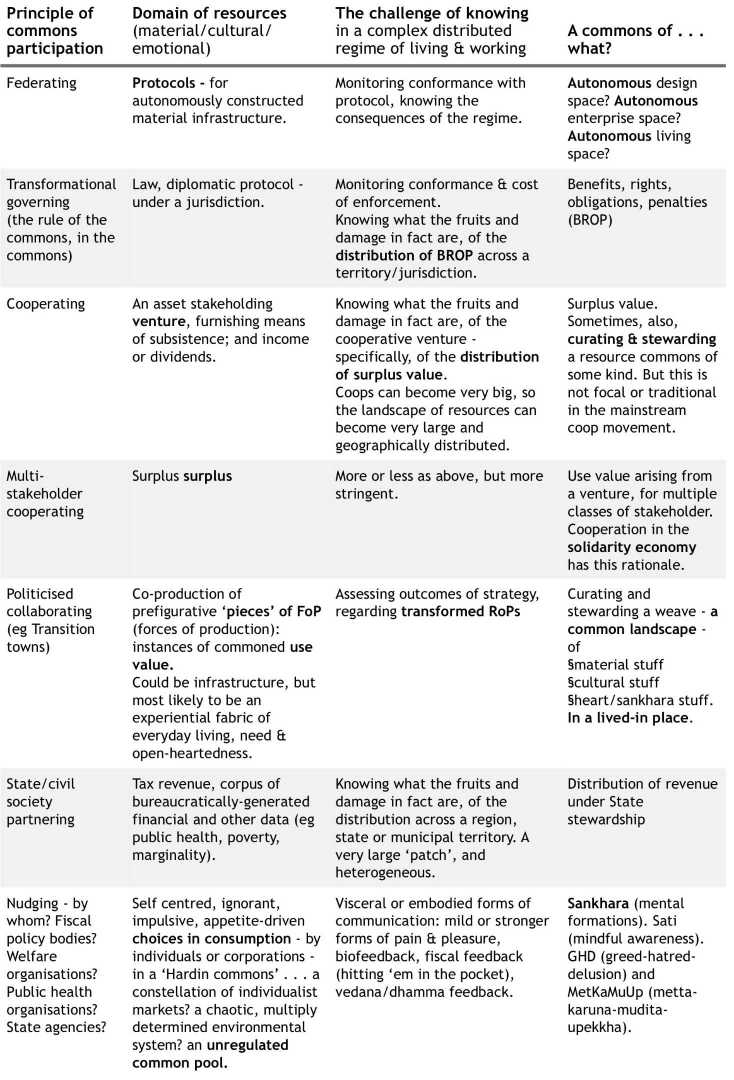Here we reproduce a piece by mike hales from July 2018, appearing in the [p2p foundation blog](https://blog.p2pfoundation.net/platforms-in-a-pluriverse-half-a-dozen-politicised-modes-of-commoning/2018/08/07) as *Platforms in a pluriverse - Half a dozen politicised modes of commoning*.
> Note: *Pluriverse* > - David Bollier interviewed by Antonis Brumas & Yavor Tarinsky (2017) > - Arturo Escobar (2015), Commons in the pluriverse’, in Bollier & Helfrich eds (2015), *Patterns of commoning*, Heinrich Bōll Foundation .
Here we engage with the means of visioning and enacting pluriversal relations in making the living economy. A core gambit is a framing of 'seven Rs' of activist commitment, which also underpins a commitment to design justice in the cultivation of infrastructure and tools.
# Here’s a libertarian socialist addressing a pluriverse . . - Many co-existing forms of commoning, in a world of profuse and inescapable difference/diversity; also, of abundance not scarcity.
- Seeing commoning as a material relation that communities and resources stand in – a system of alternative (non-capitalist, liberating) RoPs (relations of production) in the material sphere. Prefiguratively constituting a mode of production, which may evolutionarily supplant the capitalist mode. See Material landscape
- Seeing commoning, also, as requiring radical modes of knowing (an altered ‘dance of knowing’) organised under alternative (distributed) RoPs in the sphere of knowing. This is another, critical, dimension of class recomposition: a globalised recomposition of labour-power. See Cultural landscape
- In the sphere of the heart – the wellsprings of action (both wise and unwise) – commoning (and especially, multiple co-existing, differing commons) requires transverse orientation, an altered system of RoPs in the production of motivation and affiliation: open to true diversity, to mutuality across difference, to the non-Othering of different others. See Aesthetic landscape
The table below sketches six modes of participation in commons, each associated with a particular political mode: anarchist (free-libre), socialist-associationist cooperative, municipalist, consumerist, libertarian-legal.
All modes may coexist (pluriverse-wise) in communities alongside each other in the same territory. But also, multiple modes may be deployed within a given community, addressing a single commons, to deal with various dimensions of material, cultural and emotional reality.
For example, anarchists in the FLOSS/free internet movement fundamentally attempt federating around protocols. But they need to engage successfully in politicised collaborating too, in order to arrive at viable protocols. In their ‘autonomous’ lives (workplaces, families, neighbourhoods) they also are likely to engage in politicised collaborating.
Q: Platforms are infrastructure-pieces. What is the contribution that platform infrastructures – in the current digital/cloud sense – may make in each mode? In each of the modes of commoning, what are the current or traditional ways of doing it, without resorting to post-post-Fordist tech? > Note: This sketch makes no reference to Ostrom. It should, especially here, on an economy of 'infrastructure pieces'. But Ostrom is a 'scientific' outsider (an economist) and we prefer to take our lead from Bollier & Helfrich who stress the **insurgent practice** of common(ing): a practice of organiser-activists.
Q: What kind of landscape do multiple platforms and commons constitute, together and alongside one another, for a community or in a territory? This constitutes a complex, layered, institutionally-partitioned, pluriversal, material-cultural infrastructure for living and working.
> NOTE: The ‘nudging’ mode below (unselfconscious individualistic participants in an unregulated common pool) is particularly important in a context of chaotic, very large scale commoning, like 'the environment', where a Council of the Commons is very hard to constitute.

Platforming in a pluriverse